Popular information
Information for the public:
Better read-out heads for pocket-size devices (pdf)
Populärvetenskaplig information:
Känsligare läshuvud gav elektronik i fickformat (pdf)
Populärwissenschaftliche information:
Mit Nanotechnik von Riesenwiderstand zu Zwergelektronik (pdf)
Information grand public:
Têtes de lecture pour une électronique de poche (pdf)

The Nobel Prize in Physics 2007
This year’s Nobel Prize in Physics is awarded to ALBERT FERT and PETER GRÜNBERG for their discovery of Giant Magnetoresistance. Applications of this phenomenon have revolutionized techniques for retrieving data from hard disks. The discovery also plays a major role in various magnetic sensors as well as for the development of a new generation of electronics. The use of Giant Magnetoresistance can be regarded as one of the first major applications of nanotechnology.
Better read-out heads for pocket-size devices
Constantly diminishing electronics have become a matter of course in today’s IT-world. The yearly addition to the market of ever more powerful and lighter computers is something we have all started to take for granted. In particular, hard disks have shrunk – the bulky box under your desk will soon be history when the same amount of data can just as easily be stored in a slender laptop. And with a music player in the pocket of each and everyone, few still stop to think about how many cds’ worth of music its tiny hard disk can actually hold. Recently, the maximum storage capacity of hard disks for home use has soared to a terabyte (a thousand billion bytes).
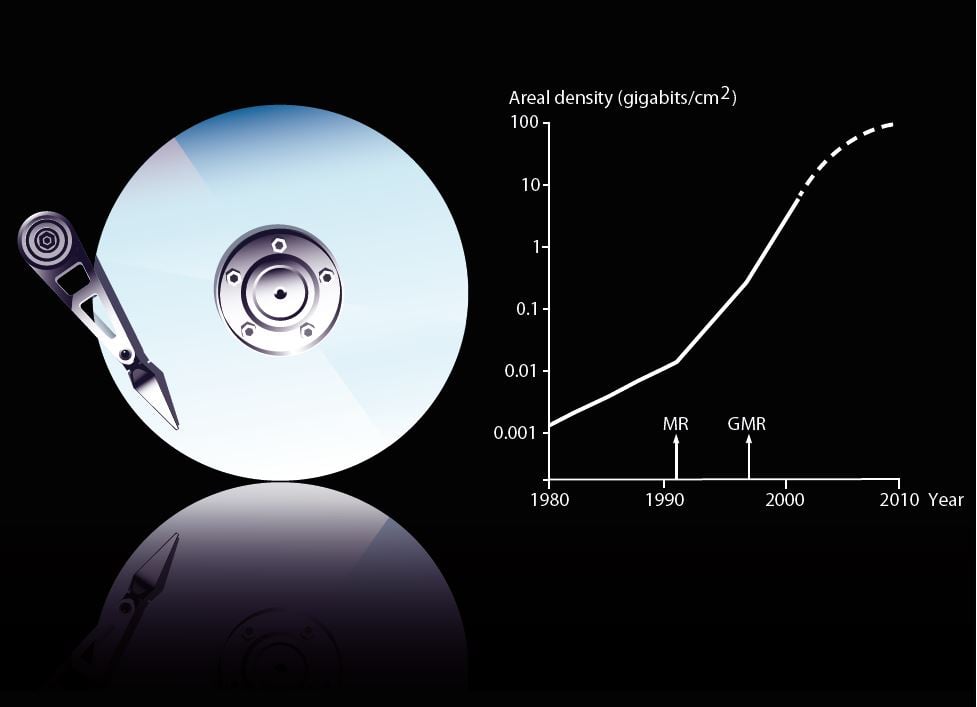
© The Royal Swedish Academy of Sciences
Diagrams showing the accelerating pace of miniaturization might give a false impression of simplicity – as if this development followed a law of nature. In actual fact, the ongoing IT-revolution depends on an intricate interplay between fundamental scientific progress and technical fine tuning. This is just what the Nobel Prize in Physics for the year 2007 is about.
Portable computers, music players, and powerful search engines, all require hard disks where the information is very densely packed. Information on a hard disk is stored in the form of differently magnetized areas. A certain direction of magnetization corresponds to the binary zero, and another direction corresponds to the binary value of one. In order to access the information, a read-out head scans the hard disk and registers the different fields of magnetization. When hard disks become smaller, each magnetic area must also shrink. This means that the magnetic field of each bite becomes weaker and harder to read. A more tightly packed hard disk thus requires a more sensitive read-out technique.
Towards the end of the 1990s a totally new technology became standard in the read-out heads of hard disks. This is of crucial importance to the accelerating trend of hard disk miniaturization which we have seen in the last few years. Today’s read-out technology is based on a physical effect that this year’s two Nobel Laureates in Physics first observed almost twenty years ago. The Frenchman Albert Fert and the German Peter Grünberg, simultaneously and independently, discovered what is called Giant Magnetoresistance, GMR. It is for this discovery that the two now share the Nobel Prize in Physics.
From Lord Kelvin to nanotechnology
Originally, induction coils where used in read-out heads, exploiting the fact that a changing magnetic field induces a current through an electric coil. Even though this technology has not been able to keep pace with the demands of shrinking hard disks, induction coils are still in use for writing information onto the disk. For the read-out function, however, magnetoresistance soon proved better suited.
It has long been known that the electric resistance of materials such as iron may be influenced by a magnetic field. In 1857, the British physicist Lord Kelvin had already published an article showing that the resistance diminishes along the lines of magnetization when a magnetic field is applied to a magnetic conductor. If the magnetic field is applied across the conductor the resistance increases instead. This (anisotropic) magnetoresistance (MR) was the direct predecessor to giant magnetoresistance as a standard technology in read-out heads. GMR took over at a point when an even more sensitive technology had become necessary.
A prerequisite for the discovery of the GMR-effect was provided by the new possibilities of producing fine layers of metals on the nanometre scale which started to develop in the 1970s. A nanometre is a mere billionth of a meter, and nanotechnology is concerned with layers consisting of only a few individual strata of atoms. Deep down at atomic level, matter behaves differently and therefore nanometre-sized structures will often exhibit totally new material properties. This is true not only for magnetism and electric conductivity, but also for properties like strength or the chemical and optical qualities of a material. In this sense, the GMR-technology may also be regarded as one of the first major applications of the nanotechnology that is now so popular in a very diverse range of fields.
Resistance and magnetization
In a metal conductor, electricity is transported in the form of electrons which can move freely through the material. The current is conducted because of the movement of electrons in a specific direction, the straighter the path of the electrons, the greater the conductance of the material. Electric resistance is due to electrons diverging from their straight path when they scatter on irregularities and impurities in the material. The more the electrons scatter, the higher the resistance.
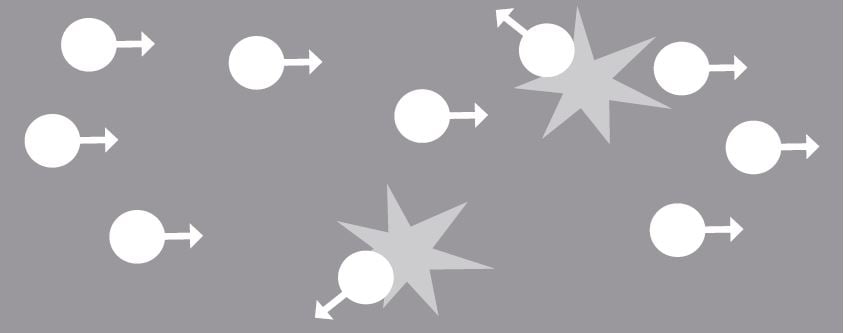
The electrical resistance in a conductor arises when electrons scatter against irregularities in the material so that their forward movement is obstructed.
© The Royal Swedish Academy of Sciences
In a magnetic material the scattering of electrons is influenced by the direction of magnetization. The very strong connection between magnetization and resistance that one finds in giant magnetoresistance arises because of the intrinsic rotation of the electron that induces a magnetic moment – the quantum mechanical property called spin – which is directed in either one of two opposite directions. In a magnetic material, most of the spins point in the same direction (in parallel). A smaller number of spins, however, always point in the opposite direction, anti-parallel to the general magnetization. This imbalance gives rise not only to the magnetization as such, but also to the fact that electrons with different spin are scattered to a smaller or greater degree against irregularities and impurities, and especially in the interfaces between materials. Material properties will determine which type of electron is scattered the most.
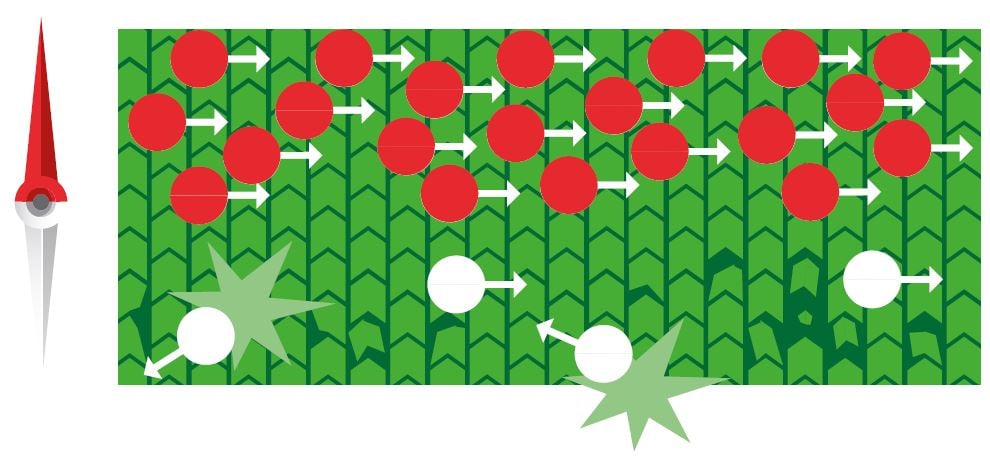
In a magnetic conductor the direction of spin of most electrons is parallel with the magnetization (red). A minority of electrons have spin in the opposite direction (white). In this example electrons with antiparallel spin are scattered more.
© The Royal Swedish Academy of Sciences
Giant Magnetoresistance – GMR
In the following an example of the simplest type of system where giant magnetoresistance can arise is described: It consists of a layer of non-magnetic metal sandwiched between two layers of a magnetic metal, see figure below. Within the magnetic material, and especially at the interface between the magnetic and the non-magnetic material, electrons with different spins are scattered differently (1). Here we will regard the case where electrons scatter more if their spin is anti-parallel to the general direction of magnetization. This implies that the resistance will be larger for these electrons than for those with a spin which is parallel to the direction of magnetization. When, next, the electrons enter the non-magnetic material they all scatter to the same degree, independent of their spin direction (2). At the second interface and within the last layer of magnetic material, electrons with anti-parallel spin will once again scatter more than electrons with parallel spin (3).
In the case when both the magnetic layers are magnetized in the same direction, most electrons will have a parallel spin and move easily through the structure. The total resistance will hence be low (case A in the figure below). However, if the magnetizations of the two layers are opposed, all electrons will be in the state of anti-parallel spin in one of the two layers. This means that no electrons can move easily through the system and the total resistance will therefore be high (case B). Now, imagine the use of this structure in a read-out head scanning a hard disk: The magnetization of layer (1) is pinned, while the magnetization of layer (3) is free to move and so can be influenced by the varying magnetic fields on the hard disk. The magnetization of the two magnetic layers in the read-out head will then be alternately in parallel and in anti-parallel to one another. This will lead to a variation in the resistance, and the current, through the read-out head. If the current is the signal leaving the read-out head, a high current may signify a binary one and a low current may signify a zero.
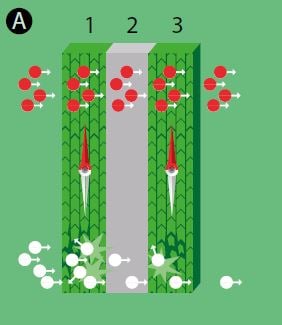
If the direction of the magnetization is the same in both magnetic layers the electrons with parallel spin (red) can pass through the entire system without scattering to any great extent. The total resistance of the system will therefore be small.
© The Royal Swedish Academy of Sciences
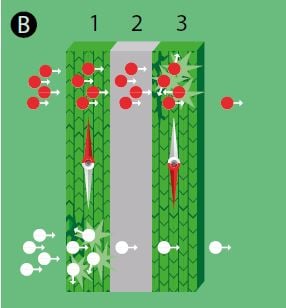
If the direction of magnetization in the two magnetic layers is opposed, all the electrons will have anti-parallel spin in one of the layers and will therefore scatter a great deal. As a result the total resistance is high.
© The Royal Swedish Academy of Sciences
GMR quickly became standard
It was in the mid-1980s that scientists in the field of magnetism realised what new possibilities nanometre-sized layers might offer. Albert Fert and his colleagues created some thirty alternating layers of iron and chromium – composed of just a few strata of atoms each. In order to succeed, they were forced to work at near vacuum, and use very low pressure gases of iron and chromium respectively. In such a set-up, the atoms will gradually attach themselves to the surface allowing the layer to be built up stratum after stratum. In a similar way, Peter Grünberg’s group created a somewhat simpler system composed of just two or three layers of iron with a layer of chromium sandwiched in between.
Partly because he had used many more layers, Fert registered a greater magnetoresistance than Grünberg. The French group saw a magnetization-dependent change of resistance of up to 50 per cent, whereas the German group saw a 10 per cent difference at the most. The basic effect and the physics behind it were however identical in the two cases. Both groups realised that they had observed a totally new phenomenon. With traditional magnetoresistance no one had registered more than a single per cent or so of change in resistance. Albert Fert was the one who coined the actual concept of giant magnetoresistance to describe the new effect, and in his first publication on the topic he pointed out that the discovery could lead to important applications. Peter Grünberg also realized the practical potential of the phenomenon and filed a patent at the same time as he was writing a first scientific publication.
For the new technology to be commercialized it was however necessary to find an industrial process to create the layers. The method used by both Grünberg and Fert (known as epitaxy) was laborious and costly, better suited for a research laboratory than for a technological process on a larger scale. Because of this, it was an important step when Stuart Parkin, an Englishman working in the United States, demonstrated that it was possible to achieve the same effect using a much simpler technology called sputtering. The GMR-effect actually proved not to depend on very perfect layers. This meant that GMR-systems could now be produced on an industrial scale. The industrial process combined with the great sensitivity of the GMR-heads, resulted in the new technology becoming standard in hard disks very soon after the first commercial GMR-head had been produced in 1997.
New electronics – spintronics
GMR meant not only a breakthrough for reading tightly packed information from hard disks (and for magnetic sensors in other applications). It is equally interesting that this technology may be regarded as the first step in developing a completely new type of electronics, dubbed spintronics. It is the use of the electron’s spin, not only its electrical charge as in traditional electronics, which is characteristic of spintronics. A general prerequisite of spintronics is provided by the small dimensions created by nanotechnology. The direction of the electron’s spin can only be maintained over very short distances; in thicker layers the direction of the spin will change before there is time to make use of the separate properties of electrons with different spin (like higher or lower resistance).
In the wake of GMR a similar system has been constructed using an electrically insulating material, instead of a non-magnetic metal, sandwiched between two layers of a magnetic metal. No electric current should be able to pass through the insulating layer, but if it is thin enough, electrons may sneak through, using a quantum mechanical effect called tunnelling. Therefore this new system is called TMR, Tunnelling Magnetoresistance. With TMR an even larger difference in resistance can be created by very weak magnetic fields, and the newest generation of read-out heads uses this technology.
Towards a universal memory
Yet another application of spintronics, which has already begun to emerge, is a magnetic working memory called MRAM. To supplement the hard disk, where information is stored permanently, computers need a faster working memory. This is usually called RAM, random access memory. In its RAM the computer stores all the information it needs to be able to process information while it is working. The drawback of the standard working memories in use today is that they are unable to store any information permanently. As this text is being written it is only stored in the RAM of the computer. If there is a power loss or somebody switches off the computer without saving, the text is lost. Only by pressing the “save”-button will the text be safely stored on the hard disk.
The point of MRAM is that it is possible to use TMR both to read and to write information and thereby create a magnetic computer memory which is fast and easily accessible. MRAM could therefore be used as a working memory, as opposed to the slower hard disk, but it would also be a permanent memory, which does not depend on electric power. This means that MRAM could develop into a universal memory which would replace both the traditional RAM and the hard disk. The compactness of such a system may prove to be particularly useful in small embedded computer systems – in everything from kitchen stoves to automobiles.
The discovery of the GMR effect was a door opener to an entire new technological field, spintronics, where both the electron’s charge and its spin are utilized. Emerging nanotechnology was once a prerequisite for the discovery of GMR: now spintronics is in its turn a driving force behind the rapid development of nanotechnology. This research area is an unusually clear example of how fundamental science and new technology intertwine and reinforce each other.
LINKS AND FURTHER READING
More information about this year’s prizes, including a scientific background article in English, is to be found at the Royal Swedish Academy of Sciences’ website, www.kva.se, and at http://nobelprize.org. You can also see the press conference there as web-TV. Further information about exhibitions and activities concerning the Nobel Prizes is available at www.nobelmuseum.se.
Scientific review articles
“Kopplung macht den Wiederstand” by Peter Grünberg, Physik Journal 9/2007 (in German).
“Giant steps with tiny magnets” by Agnes Barthélémy and Albert Fert et al., Physics World Nov. 1994 (in English).
“Spintronics” by Dirk Grundler, Physics World April 2002 (in English).
Original scientific articles
“Giant Magnetoresistance of (001)fe/(001)Cr Magnetic superlattices” by M.N. Baibich et al., Physical Review Letters Vol. 61, No. 21 (1988). (Albert Fert’s original article).
“Enhanced magnetoresistance in layered magnetic structures with antiferromagnetic interlayer exchange” by G. Binasch et al., Physical Review B, Vol. 39, No. 7 (1989). (Peter Grünberg’s original article).
Link
Presentation of the GMR-technique at IBM’s website (background, graphics and animations):
www.research.ibm.com/research/gmr.html
THE LAUREATES
ALBERT FERT
Unité Mixte de Physique CNRS/ THALES, Université Paris-Sud
Domaine de Corbeville FR-91404 Orsay FRANCE
www2.cnrs.fr/en/338.htm
French citizen. Born 1938 in Carcassonne, France. Ph.D. 1970 at Université Paris-Sud, Orsay, France.
Professor at Université Paris-Sud, Orsay, France, since 1976. Scientific director of Unité Mixte de Physique CNRS/Thales, Orsay, France, since 1995.
PETER GRÜNBERG
Forschungszentrum Jülich GmbH, Institut für Festkörperforschung DE-52425 Jülich GERMANY
www.fz-juelich.de/portal/gruenberg_e
German citizen. Born 1939 in Pilsen. Ph.D. 1969 at Technische Universität Darmstadt, Germany.
Professor at Institut für Festkörperforschung, Forschungszentrum Jülich, Germany, since 1972.
© The Royal Swedish Academy of Sciences
Nobel Prizes and laureates
Six prizes were awarded for achievements that have conferred the greatest benefit to humankind. The 14 laureates' work and discoveries range from quantum tunnelling to promoting democratic rights.
See them all presented here.
